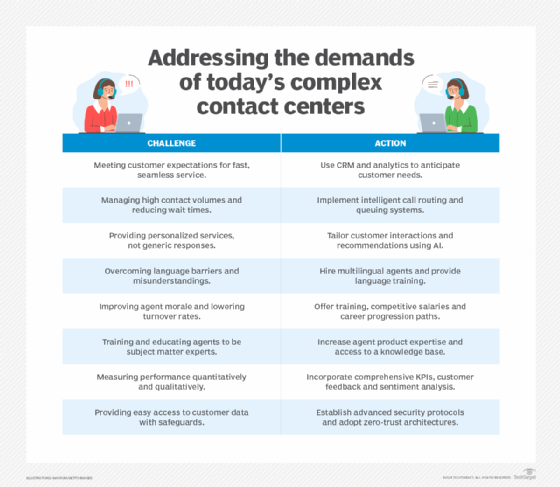8 contact center challenges in 2024 and how to overcome them
Multifunctional contact centers must meet the expectations of savvy customers, hire and maintain qualified agents, monetize data, safeguard information and modernize operations.
Contact centers are the front line of customer interactions, serving as a critical asset to business operations. They're the nexus where customer satisfaction, brand loyalty and operational efficiency converge.
Gone are the days when customer service required only a service desk or telephone. Contact centers have evolved beyond mere call-handling hubs into sophisticated, multichannel engagement centers that play a vital role in shaping customer experiences. With the advent of digital transformation, contact centers now integrate various communication platforms, including phone calls, emails, chat, social media, and even video conferencing.
The commercial landscape for businesses and customers is rapidly changing, driven by technological advancements, evolving customer expectations and the increasing importance of personalized service. Enterprises are under immense pressure to deliver consistent, high-quality customer interactions over different modes of communication, while managing costs and maintaining operational efficiency.
Interactions with customers can take almost any form, yet customers expect the same level of intimacy and understanding as they would get face-to-face. This complex environment necessitates a strategic approach to managing contact centers, addressing inherent challenges and using technology to enhance customer service capabilities.
Key contact center challenges and remedies
Providing different modes of interaction is among the many challenges for the modern contact centers. Other issues include agent attrition, increased customer expectations, ever-growing customer queues, generalization of content, barriers to understanding, and security.
1. Meeting customer expectations
Customers expect quick, personalized and seamless interactions across all channels. They also expect an interaction in one channel to be consistent with the experience they've had in other channels. They increasingly demand high levels of service and are less tolerant of delays, repeating their information and impersonal responses.
Advanced CRM systems and AI-driven analytics can help understand, contextualize and anticipate customer needs, enabling more personalized and consistent interactions. Regularly updating service protocols to align with customer feedback is equally important.

2. High contact volumes and longer wait times
Managing the high volumes of customer contacts, especially during peak times, can lead to long wait times and customer dissatisfaction. When customers call into contact centers of certain businesses, the first response they might typically get is a recording, "We're currently experiencing exceptionally high call volumes" -- at least during normal business hours. This kind of experience exacerbated by limited staffing and inefficient call routing frustrates customers.
Implementing intelligent call routing and queuing systems can optimize resource allocation and reduce wait times. Most new systems enable contact center agents to operate from home, which increases the flexibility of companies deploying agents globally. Self-service options, such as chatbots and automated responses, can alleviate pressure on human agents. Metrigy's research concludes that chatbots can handle routine types of interactions, like password resets, quick orders and simple questions, but complex situations that require empathy and understanding are still best left to humans. Improvements in machine learning and AI can also help mitigate high contact volumes and wait times and provide customers with other ways to resolve their queries independently.
3. Personalization shortfalls and content generification
Generic responses and interactions usually fail to meet customer expectations for personalized service. This lack of personalization inevitably results in decreased customer satisfaction and loyalty.
Using customer data and analytics to tailor interactions and recommendations can support a company's efforts to significantly improve customer personalization. Training contact center agents to express empathy and use customer information effectively during their interactions is especially important. New large language models can improve the quality of agent responses by combining the specifics of customer data with best practices in knowledge bases.
4. Language barriers
Contact centers often serve a diverse, global customer base. Language barriers can impede effective communication, leading to misunderstandings and frustration. Any enterprise that aspires to be global must deal with this issue. Even companies that see themselves as local will become global when they put their presence on the web.
Hiring multilingual agents and providing language training can bridge communication gaps. Additionally, real-time translation services and AI-powered language tools have come a long way and can facilitate smoother interactions.
5. Agent attrition
High turnover rates among contact center agents pose a significant challenge. Increased job openings and competition for talent in good economies can only make this problem worse. Attrition is usually costly, impacting operational efficiency and the quality of customer interactions. Factors contributing to high attrition include job stress, lack of career advancement opportunities and inadequate compensation.
Good customer service is vital to retention and brand loyalty. Implementing comprehensive training programs, offering competitive salaries and creating clear career progression paths can help reduce attrition. Providing a supportive work environment and recognizing agent contributions also play a crucial role in retaining talent. Technology has made it possible for more agents to work remotely, enabling companies to find the best qualified representatives wherever they're located.

6. Lack of subject matter expertise
Agents often face complex queries requiring specialized knowledge. As the "first line of defense" in resolving customer inquiries, it's often difficult, if not impossible, for contact center agents to achieve mastery or even appear to be knowledgeable in all aspects of company products. The result could be incorrect or inadequate information conveyed to the customer.
Continuous training and access to a centralized knowledge base can empower remote work agents with the necessary information to handle complex queries effectively. Encouraging collaboration and knowledge sharing among agents can also enhance overall understanding.
7. Quantitative and qualitative performance metrics
Accurately measuring and analyzing contact center performance is essential for continuous improvement. Traditional metrics often don't fully capture the quality of customer interactions or agent performance since measuring customer satisfaction can often be subjective.
Adopting a comprehensive set of KPIs that include quantitative and qualitative metrics can provide a more accurate picture of performance. Incorporating customer feedback and sentiment analysis into performance reviews can also provide valuable insights and a more holistic view of contact center effectiveness.
8. Data access vs. protection
Contact centers store and handle sensitive customer information, making data security a paramount concern. As the types and frequency of interactions increase, breaches are becoming more frequent and consequential, leading to significant financial and reputational damage. More sophisticated deep fakes are rendering voice recognition ineffective as a method of customer verification.
Implementing comprehensive cybersecurity measures, including encryption, multifactor authentication, and regular security audits, safeguard customer data. Sensitive customer data can be better protected through advanced security protocols, security tools such as system scanners with data loss prevention, and fraud detection. Most companies need to adopt zero trust architectures and principles, and agents need to be trained on data protection protocols. It should be standard practice to have a culture of security awareness, including periodic companywide security training.

Build on flexibility, scalability and humanity
Navigating the challenges of contact center operations requires a strategic and multifaceted approach. Customers aren't usually won over by a good contact center experience, but they're often lost because of a bad one. Tools that once helped manage queues can now provide opportunities to solve problems without human contact and improve intimacy by optimizing customer insights and context. Contact centers are likely to always be needed, but businesses now have an opportunity to enhance their customer service capabilities and ensure positive customer experiences.
The future of contact centers lies in embracing digital transformation and continuously evolving to meet the dynamic needs of customers. Integrating emerging technologies like artificial intelligence, machine learning and predictive analytics will enhance contact center operations. By keeping abreast of technological advancements while maintaining a customer-centric approach, businesses can turn their contact centers into strategic assets that drive customer satisfaction, loyalty and overall business success. Technology, however, should assist and enhance, not replace, human interactions.
Jerald Murphy is senior vice president of research and consulting at Nemertes Research. He has more than three decades of technology experience, including neural networking research, integrated circuit design, computer programming, global data center designing and CEO of a managed services company.







